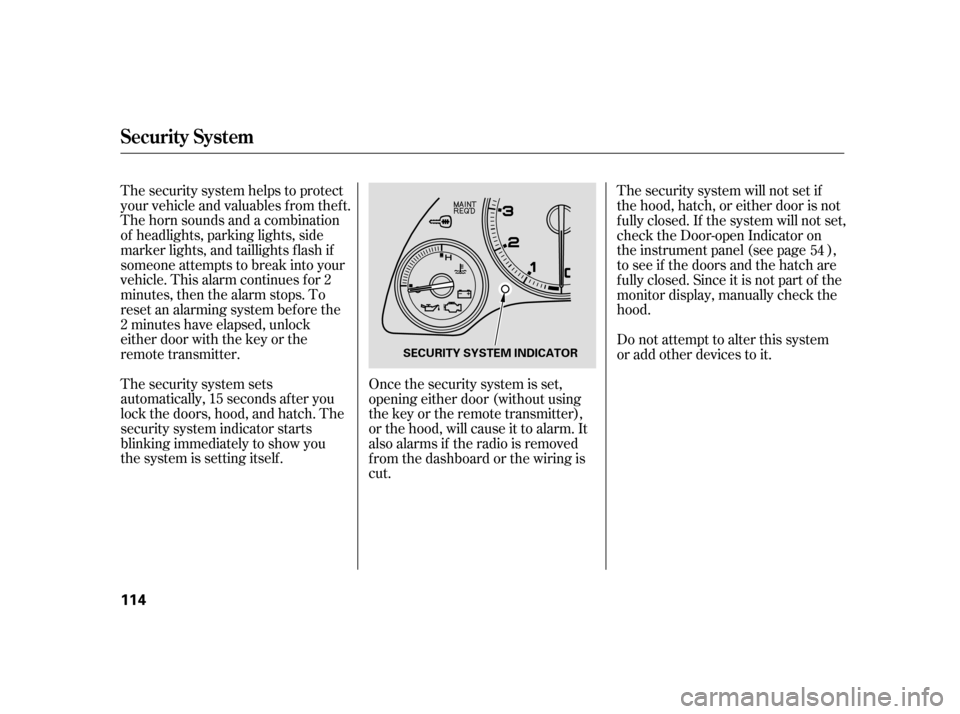lock Acura RSX 2005 Owner's Guide
[x] Cancel search | Manufacturer: ACURA, Model Year: 2005, Model line: RSX, Model: Acura RSX 2005Pages: 243, PDF Size: 3.42 MB
Page 91 of 243

Air conditioning places an extra load
on the engine. Watch the engine
coolant temperature gauge (see page) when using the A/C in heavy
traf f ic or driving up long hills. If it
moves near the red zone, turn of f the
air conditioning until the gauge
reads normally.
This button controls the source of air
going into the system. When the
indicator in this button is on, the
system is recirculating the interior
air (Recirculation mode). When the
indicator is of f , f resh air is brought
in f rom outside the vehicle (Fresh
Air mode). Push the button to
change between recirculated and
f resh air. Use Recirculation mode to heat or
cool the interior more quickly, or to
keep out smoke and dust. Leaving
the system in the Recirculation mode
with the A/C off can cause the
windows to fog up. Switch to Fresh
Air mode as soon as the interior
reaches a comf ortable temperature
or the outside smoky, dusty condi-
tion clears.
You can manually select the f an
speed by turning the f an speed
control dial. Turning this dial
clockwise increases the f an speed,
which increases air flow.
When the dial is set to AUTO, the
system controls the f an speed
automatically.
Use this dial to select the direction of
airf low coming out of the system.
Some air will come out of the side
vents in all modes.
In AUTO mode, the system controls
the air f low direction automatically
between the dashboard vents and
the f loor vents.
The main air flow comes out
of the dashboard vents.
The main air flow is directed
to the floor vents. Airf low is divided between
the vents in the dashboard and the
f loor vents.
The main air flow is divided
between the floor vents and
defroster vents at the base of the
windshield.
58
Vents, Heating, and A/C
Recirculat ion But t on
Fan SpeedMode Cont rol Dial
90
Page 114 of 243

If your vehicle’s battery is
disconnected or goes dead, you will
need to set the clock.
Press and hold the CLOCK button.
ChangethehourbypressingtheH
button until the numbers advance to
the desired time. Change the minute
by press the M button until the
numbers advance to the desired time.When you are f inished, release the
CLOCK button.
You can quickly set the time to the
nearest hour. If the displayed time is
bef ore the half hour, pressing and
holding the CLOCK button, then
pressing the R (RESET) button sets
the clock back to the previous hour.
If the displayed time is after the halfhour, the clock sets f orward to the
beginning of the next hour.
1:06 will reset to 1:00
1:52 will reset to 2:00
For example :
Setting the Clock
A ll models except T ype-S
T ype-S
Features
113
CLOCK BUTTON
RESET BUTTON RESET
BUTTON
CLOCK BUTTON
HOUR BUTTON
MINUTE BUTTON MINUTE BUTTON
HOUR BUTTON
Page 115 of 243

The security system helps to protect
your vehicle and valuables f rom thef t.
The horn sounds and a combination
of headlights, parking lights, side
marker lights, and taillights f lash if
someone attempts to break into your
vehicle. This alarm continues for 2
minutes, then the alarm stops. To
reset an alarming system bef ore the
2 minutes have elapsed, unlock
either door with the key or the
remote transmitter.
The security system sets
automatically, 15 seconds after you
lock the doors, hood, and hatch. The
security system indicator starts
blinking immediately to show you
the system is setting itself.Once the security system is set,
opening either door (without using
the key or the remote transmitter),
or the hood, will cause it to alarm. It
also alarms if the radio is removed
f rom the dashboard or the wiring is
cut.The security system will not set if
the hood, hatch, or either door is not
f ully closed. If the system will not set,
check the Door-open Indicator on
the instrument panel (see page ),
to see if the doors and the hatch are
f ully closed. Since it is not part of the
monitor display, manually check the
hood.
Do not attempt to alter this system
or add other devices to it.
54
Security System
114
SECURITY SYSTEM INDICATOR
Page 128 of 243

Your dealer has Acura accessories
that allow you to personalize your
vehicle. These accessories have
been designed and approved f or your
vehicle, and are covered by warranty.
Although aftermarket accessories
may f it on your vehicle, they may not
meet f actory specif ications, and
could adversely af f ect your vehicle’s
handling and stability. Modif ying your vehicle, or installing
some non-Acura accessories, can
make it unsaf e. Bef ore you make any
modif ications or add any accessories,
be sure to read the f ollowing
inf ormation.When properly installed, cellular
phones, alarms, two-way radios, and
low-powered audio systems should
not interf ere with your vehicle’s
computer controlled systems, such
as your airbags and anti-lock brakes.Bef ore installing any accessory:
Make sure the accessory does not
obscure any lights, or interf ere
with proper vehicle operation or
perf ormance.
Be sure electronic accessories do
not overload electrical circuits
(see page ) or interf ere with
proper operation.
Have the installer contact your
dealer for assistance before
installing any electronic accessory. 208
A ccessories
A ccessories and Modif ications
Bef ore Driving
127
Improper accessories or
modifications can affect your
vehicle’s handling, stability, and
performance, and cause a
crash in which you can be hurt
or killed.
Follow all instructions in this
owner’s manual regarding
accessories and modifications.
Page 129 of 243

Some examples are:Lowering your vehicle with an
aftermarket suspension kit that
signif icantly reduces ground
clearance can allow the
undercarriage to hit speed bumps
or other raised objects, which
could cause the airbags to deploy.
Raising your vehicle with an
af termarket suspension kit can
af f ect the handling and stability.
Af termarket wheels, because they
are a universal design, can cause
excessive stress on suspension
components. Larger or smaller wheels and tires
can interf ere with the operation of
your vehicle’s anti-lock brakes and
other systems.
Removing parts f rom your vehicle,
or replacing components with
af termarket components could
seriously af f ect your vehicle’s
handling, stability, and reliability. Modif ying your steering wheel or
any other part of your vehicle’s
safety features can make the
systems inef f ective.
If you plan to modif y your vehicle,
consult your dealer.
Modif ying Your Vehicle
A ccessories and Modif ications
128
Page 132 of 243

Store or secure all items that could
be thrown around and hurt
someone during a crash.
Be sure items placed on the f loor
behind the f ront seats cannot roll
under the seats and interf ere with
the pedals or seat operation.Distribute cargo evenly on the
f loor of the cargo area, placing the
heaviest items on the bottom and
as far forward as possible.
If youfolddownthebackseat,tie
down items that could be thrown
about the vehicle during a crash or
sudden stop.
Do not place items on the cargo
area cover, or stack objects higher
than the top of the back seat. They
could block your view and be
thrown about the vehicle during a
crash or sudden stop.If you carry large items that
prevent you f rom closing the
hatch, exhaust gas can enter the
passenger area. To avoid the
possibility of
, f ollow the instructions
on page .
Keep the glove box closed while
driving. If it is open, a passenger
could injure their knees during a
crash or sudden stop. If you can carry any items on a
roof rack,besurethetotalweight
of the rack and the items does not
exceed the maximum allowable
weight. Please contact your dealer
for further information.45
Carrying Items in the Passenger
Compartment
carbon monoxide
poisoning
Carrying Cargo in the Cargo A rea
or on a Roof Rack
Carrying Cargo
Bef ore Driving
131
Page 134 of 243

This section gives you tips on
starting the engine under various
conditions, and how to operate the
manual and automatic transmissions.
It also includes important
information on parking your vehicle,
the braking system, and f acts you
need if you are planning to tow a
trailer.........................
Preparing to Drive .134
.......................
Starting the Engine .135
.................
Manual Transmissions . 136
..............
Automatic Transmission . 139
...........................................
Parking .145
.............................
Braking System .146
...............
Anti-lock Brakes (ABS) . 147
...........................
Towing a Trailer .148
Driving
Driving
133
Page 135 of 243

Youshoulddothefollowingchecks
and adjustments every day bef ore
you drive your vehicle.Make sure all windows, mirrors,
and outside lights are clean and
unobstructed. Remove f rost, snow,
or ice. Check the seat adjustment (see
page ).
Check the adjustment of the
inside and outside mirrors (see
page ).
Check the steering wheel
adjustment (see page ).
Make sure the doors and the
hatch are securely closed and
locked.When you start the engine, check
the gauges and indicators in the
instrument panel (see page ).
Check that the hood is f ully closed. Fasten your seat belt. Check that
your passengers have f astened
their seat belts (see page ).
Check that the hatch is f ully
closed.
Check that any items you may be
carrying are stored properly or
f astened down securely. Visually check the tires. If a tire
looks low, use a gauge to check its
pressure.
1.
2.
3.
9. 8. 7. 6.
5. 4. 10. 11.
71
79 63
15 51
Preparing to Drive
134
Page 137 of 243

The manual transmission is syn-
chronizedinallforwardgearsfor
smooth operation. It has a lockout so
you cannot shift directly from Fifth
to Reverse. When shif ting up or
down,makesureyoupushtheclutch
pedal down all the way, shift to the
next gear, and let the pedal up
gradually. When you are not shif ting,
do not rest your f oot on the clutch
pedal. This can cause your clutch to
wear out faster.Come to a full stop before you shift
into Reverse. You can damage the
transmission by trying to shift into
Reverse with the vehicle moving.
Push down the clutch pedal, and
pause f or a f ew seconds bef ore
shif ting into Reverse, or shif t into
one of the f orward gears f or a
moment. This stops the gears so
they won’t ‘‘grind.’’
When slowing down, you can get
extra braking f rom the engine by
shifting to a lower gear. This extra
braking can help you maintain a safe
speed and prevent your brakes f rom
overheating while going down a
steep hill. Bef ore downshif ting,
make sure the engine speed will not
go into the tachometer’s red zone in
the lower gear.
Manual T ransmissions
136
Rapid slowing or speeding-up
can cause loss of control on
slippery surfaces. If you crash,
you can be injured.
Use extra care when driving on
slippery surfaces.
Page 139 of 243

With the clutch pedal pressed,
move the shift lever to the first/
second gear side of the Neutral
gate, then shif t to Reverse.If you are still unable to shif t to
Reverse, apply the parking brake,
andturntheignitionkeyto
ACCESSORY (I) or LOCK (0).
Press the clutch pedal, and shif t to
Reverse.
With the clutch pedal still pressed,
start the engine.
The 6-speed manual transmission
has an electric lockout so you cannot
accidentally shif t f rom Fif th to
Reverse instead of Sixth while the
vehicle is moving. If you cannot shif t
to Reverse when the vehicle is
stopped:
If you need to use this procedure to
shif t to Reverse, your vehicle may be
developing a problem. Have the
vehicle checked by your dealer.
1. 2.
3.
4.
Reverse Lockout
Manual T ransmissions
138